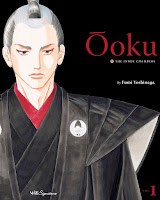In seventeenth century Japan, a plague called the Red Pox inflicts only men, decimating the male population. With so few men left in the country, women take over the roles of men, becoming farmers, shopkeepers, and heads of households. Healthy men are prized, and only wealthy women are able to take them as husbands. Despite these reversals, women are not to rule, leaving politics to men, but the current shogun is secretly a woman. Rather than the traditional female concubines, her inner chambers are filled with men - men who can never leave, lest they reveal the true gender of their imperial ruler.
The first two volumes in the "Ōoku" series tell the origins of the first few female shoguns. Issues arise with pride and jealousy between the men and whom the shogun favors at that moment. Love is rare and cherished but cannot always be embraced as the men must be able to produce heirs with the shogun; otherwise, a shogun is forced to move on to a new male partner. The female concubine is frequently portrayed in fiction, while Ōoku is utterly unique for its frank portrayal of male concubines and their lives.


No comments:
Post a Comment